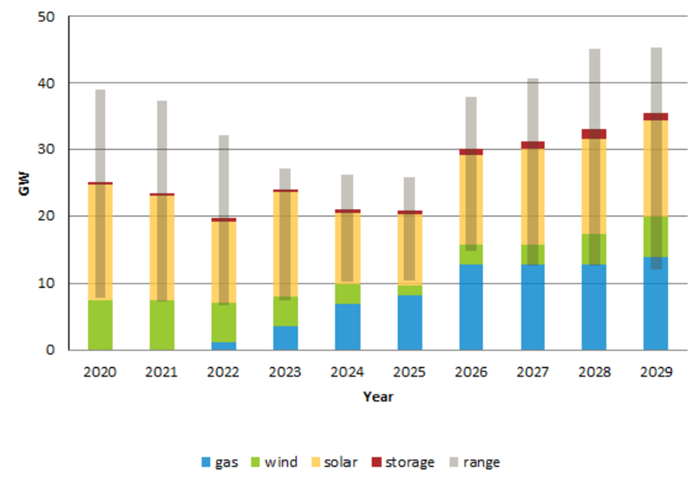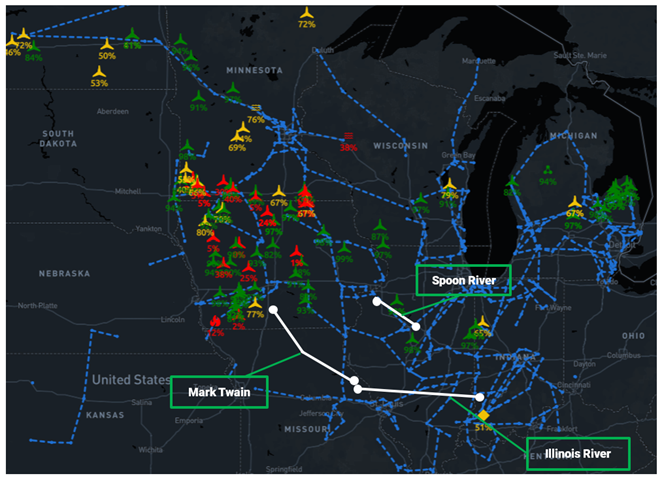Discuss your challenges with our solutions experts
MISO's generation overhaul and transition towards renewables
An update on MISO's supply stack changes and the need for interregional transmission capacity
The generation queue
As the Midwest charges ahead in its generation transformation, renewables are expected to double their market share in a matter of years. Midcontinent Independent System Operator (MISO) is quickly shifting away from its thermal generation-based fleet towards a more diverse, renewables-based fleet. The recent generation additions and retirements across MISO Classic emphasize the need for grid reliability and an increase in interregional transmission capacity.
While MISO's efforts to revamp the supply stack are occurring in all three regions, there is added emphasis on MISO Central. Historically, the region is known for its robust coal generation and limited renewable generation. Efforts to address the outdated thermal generation began in the early 2000s, but substantial changes have been implemented recently, with 17.5 GW of coal retiring over the last ten years.
In recent years, scientific research, public support, and favorable economics have driven the renewable energy transition throughout the Midwest. As a result, an additional 6.7 GW of coal is scheduled to come offline by 2030 in MISO Central. In MISO North it is predicted that another 787 MW of coal will retire by 2030, according to the EIA.
The other half of the supply stack equation is the increase in renewables. The market is scheduled to see a large influx of solar, wind, and storage capacity in the upcoming years. To date, MISO North is significantly ahead of Central in terms of wind generation, holding 80% of the footprint’s capacity. Due to a more favorable geographic location and a head start on capacity, MISO North will continue to hold a larger proportion of wind despite the expected growth in Central. Solar generation is another new and growing resource in MISO.
Currently, solar makes up a small portion of the 13% renewable portfolio in MISO, but it is expected to grow monumentally soon. Additionally, storage development is beginning to make its way into the footprint as a mechanism for ensuring grid reliability and resource adequacy. The increase in wind and solar and decrease in coal heightens the need for storage and an alternative baseload resource to meet power demand when wind and solar generation are not available. Despite the relatively small volume of storage in the queue, it is promising to see that storage is incorporated in MISO’s future generation mix.
Figures 1 and 2 below display the potential renewable generation composition in MISO by 2029. The Forecasted Queue Volume within the MISO Transmission Expansion Plan (MTEP) reflects project development efforts to increase installed capacity. While there is a high risk for queue cancellations and delays that will alter the volume of these projections, the general trend highlights the continued growth of renewables.
The generation queue is directly linked to the available transmission capacity and MISO’s ability to deliver power from where it is generated to where it is needed. Without this transmission component, renewable penetration will be limited.
Figure 1: Forecasted renewable generation queue through 2029
Source: MISO 2020 Transmission Expansion Plan
Figure 2: Forecasted queue volume (GW) and generation composition through 2029
Source: MISO’s 2020 Interconnection Queue Outlook, cdn.misoenergy.org/MISO2020InterconnectionQueueOutlook445829.pdf
Interregional transmission capacity
MISO’s queue of renewable projects heightens the need for interregional transmission capacity. As wind penetration intensifies in MISO Classic, specifically in North, the frequency and magnitude of west-east flows will increase across the footprint. The solar additions are expected to be more widespread across MISO, but transmission upgrades will still be necessary to move power to regions with low renewable penetration.
The MISO Futures Whitepaper (April 2020) indicated that renewables could make up 30% of the supply stack by 2026 if there is careful planning and regional collaboration, and transmission upgrades are a critical component of this.
In MISO’s Renewable Integration Impact Assessment (RIIA) published last month, MISO addressed the need for transmission upgrades to both deliver power from renewable sources to demand centers and also provide grid stability. This report also highlighted the importance of transmission upgrades for meeting renewable penetration goals. Without transmission equipment upgrades, congestion will increase substantially with rising renewable supply, leading to significant wind and solar curtailment, limiting renewable penetration into the supply stack. As such, transmission upgrades are essential for the renewable transition in the Midwest.
One recent transmission upgrade project is Ameren’s Grand Rivers Project. The project originated in 2011 and received full approval in 2014 by the Illinois Commerce Commission (ICC). The first phase was the Spoon River Project, a 44-mile line in northwest Illinois that spans from Galesburg to Peoria and entered service in February 2018.
The second phase was the Mark Twain Project, a 96-mile line in northeast Missouri and Iowa that spans from Palmyra to Kirksville and entered service in December 2019. Most recently, the Illinois Rivers Project entered service in December 2020. This was the largest phase of the project: a 375-mile line through the entire state of Illinois with smaller additions from Meredosia to Ipava and Rising to Sidney. The goal of this project was to increase energy reliability in MISO, expand access to clean and affordable energy, and help meet the growing needs for electricity in the Midwest.
As the graphic below shows, the new line additions tie into the established 345 kV system in Central and begin farther west where there is a significant drop-off in 345 kV transmission capacity. This upgrade works to facilitate the expansion of renewables to reach more Midwestern families and businesses. According to feedback collected by Ameren, the upgrade proved successful in lowering rates for clients and improving overall satisfaction.
Three phases of the Grand Rivers Transmission upgrade
Source: Wood Mackenzie North America Power Solutions
The Grand Rivers Project has set a standard for changes needed across MISO. As clean energy and renewable penetration increase, so must our interregional transmission capacity. Currently, there are only a handful of corridors between MISO North and Central that can adequately transfer power. The generation queue of additions and retirements is set to out-pace transmission line expansion, and it is critical that the ISO continues to expand transmission capacity and upgrade equipment to support increased renewable penetration.
More projects like Grand Rivers will enable renewable development to thrive. But until this simultaneous development of generation, storage, and transmissions occurs, reliability, stability, and renewable penetration will be compromised.
The future
The Midwest transition to a renewable economy is here to stay, as demonstrated by supply stack changes and commitments from multiple states within MISO. States have joined the US Climate Alliance and formed smaller subcommittees within their departments that focus solely on renewable development and serving its constituents through a clean economy. Governor Tim Walz of Minnesota announced his plan for ‘clean car’ standards and 100% clean energy by 2050. Governor Gretchen Whitmer of Michigan issued an executive order to become carbon neutral by 2050, and Governor Tony Evers of Wisconsin signed an executive order for 100% clean energy use by 2050.
Planning ahead for MISO’s generation shift and clean economy expansion is both complicated and multifaceted. The renewable generation queue, the Grand Rivers Project, and government initiative from Midwest states show that progress is being made, but continued transmission upgrades are essential to maximizing MISO’s renewable development potential.
Be the first to know
Stay updated on changes to the market with our North America Power Solutions. To learn more about what can do for your business, or to speak with an expert, please fill out the form at the top of this page.








